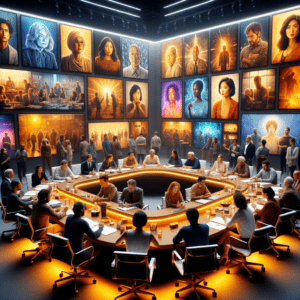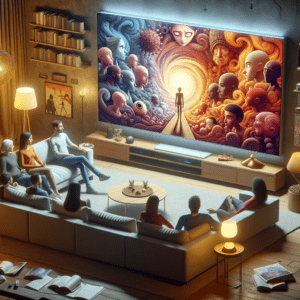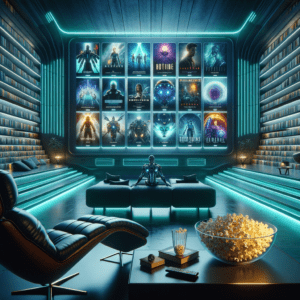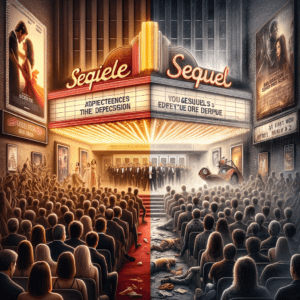You know, there’s something about those TV characters—the ones that make you sit there all cozy on the couch, munching popcorn, then BAM—make you question everything about right and wrong. I’ve always been kind of enamored with antiheroes. Not quite saints, not entirely devils, they’re like us in so many flawed ways. Digging into them, it’s like peeling an onion—layer after layer of human complexity. Their stories are a beautifully orchestrated dance, and the writers? They’re the maestros of this deeply human symphony.
I mean, just consider Walter White from “Breaking Bad.” Talk about a roller coaster! Starting off as a mild-mannered chemistry teacher and turning into a meth lord—I mean, really! Yet somehow, in all this chaos, you find yourself feeling for the guy. Yeah, go figure. The magic in creating such characters is like this secret alchemical recipe—it requires this fascinating blend of virtues and vices that either turns into treasure or sometimes, well, yikes.
The Birth of an Antihero
Alright, let’s dive in. What’s it that makes these antiheroes tick? I reckon it’s that mish-mash of good intentions gone awry and that murky moral middle ground that intrigues us. Imagine a world painted in a million shades of gray. How do our beloved antiheroes navigate this world? Ambition, frustration, sheer survival… those are the life threads that push and pull them, creating characters that breathe and struggle just like us.
Traditional villains can feel so… one-note, but an antihero? They blur the lines between protagonist and antagonist, offering intricate portrayals that tug at our empathy. We don’t just cheer for their victories; we chew over their choices—both the terrible and the understandable. It’s like this endless game of emotional chess, and yep, we’re all in.
No way can a stale villain hold a candle here. Antiheroes? They’re layered—like an emotional lasagna full of history and hidden struggles. The writers tantalize us, slowly revealing their demons. It’s this build-up, a connection woven through struggles that hits our soft spots.
Imperfections Make Perfection
Oh, those lovely, delightful little flaws! They make characters deliciously imperfect—kinda like that only slightly burnt toast that hits the spot. Antiheroes, they’re human, they’re fallible—tripping, stumbling, dusting themselves off. And somehow, we cheer them on.
Tony Soprano comes to mind—a mob boss for Pete’s sake! And yet, his battles with anxiety strike a chord. It’s a stroke of genius, really, the way writers invest their larger-than-life figures with everyday problems. In antiheroes, flaws aren’t mere obstacles; they’re the heartbeats of their journeys.
Those flaws? They’re our mess, the complexities we can oddly cheer for. When a character fights emotional battles—tangled family ties, the stress of work, the duality of self—we see a mirror. There lies the beauty: a compelling mess we can’t help but engage with.
Gray Morality and the Space Between
Our world isn’t just black and white, and the television landscape? It better reflects that complexity. Antiheroes thrive in this gray expanse between ethical extremes, pushing us to explore moral depths we’d rather ignore. Writers pull our strings, making us double-take our own principles.
Think about Dexter—a serial killer by all definitions, but with a conscience-driven code. Does that make him good or evil? Neither answer is complete, and that unsettling enigma is the whole crux. Dexter lives in that shady area, challenging us to ponder our comfortable ethics.
Creative minds behind the screen keep us teetering on edge, dangling situations that challenge what’s right and wrong. By twisting heroic actions and dipping them in moral gray, antiheroes deliver awakening narratives. And therein cultivates a pulse like none other—raw, real, arresting.
Motivation and Redemption
But why, oh, why do antiheroes choose such paths? What’s the fuel for their drastic decisions? Motivation lights the fire under our antihero tales. Whether it’s like, a need for wealth, vengeance, love, or pure survival instincts, it all traces back to this core event or desire.
Look at Walter White again—from desperate teacher to ruthless kingpin, motivated by a need to secure his family after cancer rears its ugly head. It’s not thrill-seeking; it’s a crazy cocktail of survival tinged with deep-seated resentment.
With skilled hands, writers carve motives like sculptors—attaching characters’ actions to truths we find relatable. Then comes redemption—not always loud, sometimes subtle, but oh so satisfying. A good redemption arc beats in these stories, sometimes shifting our feelings unexpectedly. Because to be honest, who doesn’t love witnessing redemption unfold?
The Subtle Concept of Acceptance
What tickles me about antiheroes is how we, the audience, unwittingly become participants in a moral ride. The narratives thread in such a way, we inch closer to understanding, sometimes even justifying questionable actions.
Take “The Shield,” it nails this with Vic Mackey, a cop clearly corrupted and morally ambiguous. Yet, the show draws us into his world, making us see things his way. And suddenly, look at that, our own morality breathes that skewed yet somehow validating air. You know? It’s a tightrope storytelling act—don’t look down, or you might just question where your heart sympathies truly lie.
The Human Condition
Maybe the reason we’re so captivated by these antiheroes is they reflect the facets of ourselves—enmeshed in the epic storytelling spotlight. They struggle, they hurt, they try, and they flub up, sometimes as gloriously as we do. They embody layers and fibers of the human saga, echoing our own quests for self-understanding.
So here’s my parting thought: building a complex antihero isn’t tossing random traits into a pot and stirring. It’s about establishing an audience connection—a wild, tangled dance between defiance of and allegiance to our core values. TV writers, hats off to them, they’re masters of such vibrant performances, leaving us pondering, “In their shoes, what would I do?”
Next time you’re glued to that screen, rooting for these beautifully flawed characters, hit pause. Look deeper. Yep, there’s your inner antihero, nodding back. It’s a collaboration, this sweep of storytelling symphony. Because life? It’s not just heroism and shiny intent, ya know—it’s more often than not, a captivating mosaic of glorious chaos. Ain’t that something we can all see ourselves in?















